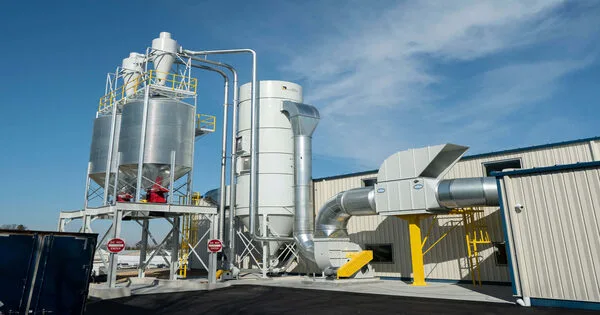A dust collection system is a necessary component in many businesses and woodworking shops to improve air quality by removing dust and other particulates from the air. It is an air quality enhancement technology used in industrial, commercial, and residential production facilities to improve breathable air quality and safety by eliminating particulate matter from the air and environment. It contributes to a cleaner and safer working environment while preventing dust-related health problems.
Dust collection systems follow the basic formula of capture, deliver, and collect. First, the dust must be collected or removed. This is performed using equipment such as capture hoods, which catch dust at its source of origin. Many times, the machine producing the dust will have a port to which a duct can be directly attached.
Second, the dust must be transported. This is accomplished using a ducting system that is correctly designed and manifolded to maintain a consistent minimum air velocity required to keep the dust suspended for transport to the collection device. An incorrectly sized duct might cause particles to settle in the duct system and obstruct it.
Finally, dust is gathered. This is accomplished through a variety of methods, depending on the application and the dust being handled. It could be a simple pass-through filter, a cyclonic separator, or an impingement baffle. It can also be as intricate as an electrostatic precipitator, a multistage baghouse, a chemically treated wet scrubber, or a stripping tower.
Here are some key aspects of a dust collection system:
(a) Components:
- Dust Collector: This is the core component that captures and collects dust. There are different types, such as single-stage and two-stage collectors.
- Ductwork: A network of ducts is used to transport dust from various collection points to the central collector.
- Hoods and Blast Gates: Hoods are positioned at dust-producing machines, and blast gates control the airflow to each machine, optimizing suction.
(b) Types of Dust Collectors:
- Single-Stage Collectors: These collect dust and debris in a single step, typically using a large impeller to create suction and a bag or canister to capture the dust.
- Two-Stage Collectors: These have a pre-separator or cyclone that removes larger particles before the air and finer dust reach the main filter. This improves efficiency and reduces the frequency of filter cleaning or replacement.
(c) Filter Media:
- Bag Filters: Commonly used in single-stage collectors, they are effective for capturing larger particles.
- Cartridge Filters: Typically used in two-stage collectors, they offer a greater surface area for filtration and are more efficient in capturing finer particles.
Regular Maintenance:
Regular cleaning and maintenance are essential to ensure the system operates at peak efficiency. This includes emptying dust collection bags or canisters, cleaning or replacing filters, and inspecting ductwork for any blockages.
Safety Considerations:
Ensure that the system conforms with all safety requirements and standards. It is critical to avoid fire threats by employing adequate spark arrestors and ensuring proper grounding. It can be noisy. To reduce noise impact on the workspace, consider soundproofing or moving the equipment to a separate room.
Investing in a well-designed and regularly maintained dust collection system not only fosters a healthier work environment, but it also increases the lifespan of machinery by reducing the quantity of dust that can gather on it.
















